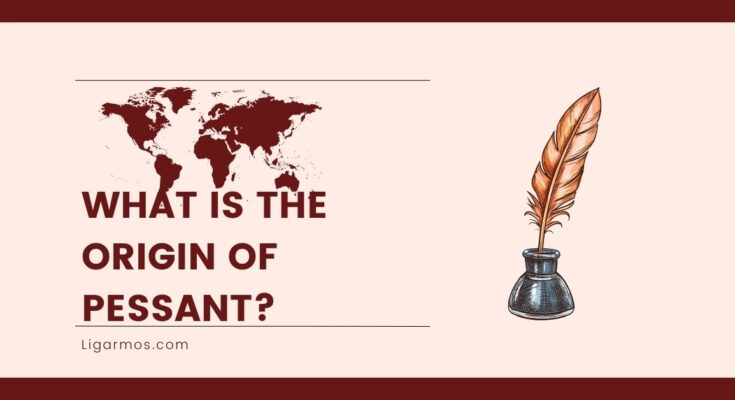Table of Contents
Introduction to Pessant
Welcome to the intriguing world of Pessant, where history intertwines with culture and controversy. Have you ever wondered about the origins of this enigmatic object?
Join us on a journey through time as we unravel the mysteries behind Pessant, exploring its ancient roots, evolution in medieval Europe, and modern-day adaptations.
Get ready to delve into the fascinating tale of Pessant – a story that spans civilizations and sparks debates to this day.
The History of Pessant
Pessant, a term that carries historical weight, has roots stretching back through time’s annals. Its origins can be traced to ancient civilizations like Mesopotamia and Egypt, where early forms of contraception were utilized by women seeking control over their reproductive health.
In medieval Europe, peasants evolved into more refined methods of birth control, often involving herbal remedies and rudimentary barrier techniques.
These practices varied widely across different regions but shared the common goal of preventing unwanted pregnancies.
The role of peasants in various cultures and societies reflected differing attitudes towards sexuality and reproduction.
While some communities embraced its use openly, others shrouded it in secrecy due to societal taboos surrounding contraception.
Today, peasants have undergone significant modernization with the development of highly effective contraceptive options such as hormonal pills and intrauterine devices.
Despite this progress, debates still linger regarding the appropriation and ownership of traditional contraceptive practices like peasants.
Ancient Origins: From Mesopotamia to Egypt
Travel back in time to the cradle of civilization, ancient Mesopotamia, where the origins of pessant can be traced. In this fertile land between the Tigris and Euphrates rivers, early civilizations used primitive forms of peasants for various purposes.
From Mesopotamia, the use of peasants spread to Egypt, where it became intertwined with religious practices and daily life.
The Egyptians developed more sophisticated versions of pessant, incorporating intricate designs and materials like precious metals and gemstones.
In both Mesopotamia and Egypt, pessant served practical functions and carried symbolic meanings related to fertility, protection, and power.
These ancient cultures believed in the magical properties of pessant to ward off evil spirits or bring blessings upon its wearer.
The journey of the peasant from Mesopotamia to Egypt marked a significant cultural exchange that influenced its evolution throughout history.
Evolution of Pessant in Medieval Europe
During medieval times in Europe, the concept of pessant evolved into a more structured form. It transitioned from being solely a contraceptive method to also encompassing elements of religious significance and societal control.
The medieval era brought about an increased focus on morality and the regulation of sexual behavior. Pessants were not only seen as tools for preventing pregnancy but also as symbols of virtue and purity.
In some regions, pessants became associated with superstitions and folklore, further shaping their societal role. They were often linked to beliefs in warding off evil spirits or ensuring fertility blessings from deities.
As societal norms shifted throughout the Middle Ages, so did the perception and use of pessants. Their evolution mirrored the changing attitudes toward sexuality, marriage, and women’s rights during this tumultuous historical period.
The Role of Pessant in Different Cultures and Societies
The role of Pessant in different cultures and societies is as diverse as the people who use it. From ancient civilizations to modern-day practices, Pessant has played a significant part in various traditions and rituals.
In some cultures, pessant is seen as a symbol of fertility and abundance, and it is used in ceremonies to invoke blessings for prosperity and growth. In others, it holds spiritual significance, believed to ward off evil spirits or bring good luck.
Throughout history, Pessant has been integrated into cultural practices like dance performances, religious ceremonies, and healing rituals. Its presence can be found across continents and periods, showcasing its adaptability and enduring appeal.
Whether used for medicinal purposes or simply as an aesthetic embellishment, the role of Pessant transcends boundaries of language and geography. Its meaning may vary from culture to culture but its impact remains undeniable.
Modern Uses and Adaptations of Pessant
In modern times, Pessant has undergone significant transformations. Today, it is not just a form of protection but also a symbol of empowerment and liberation for many individuals.
With advancements in technology and design, Pessant has become more discreet and comfortable to use.
Moreover, modern adaptations have made Pessants more accessible to a wider range of people. From different sizes to materials used, numerous options are now available to cater to individual needs and preferences. Additionally, the evolution of sustainable and eco-friendly alternatives has brought a new dimension to Pessant usage.
Furthermore, innovative features such as applicators and lubricants have enhanced the user experience. Pessant’s modern uses and adaptations reflect society’s evolving attitudes towards sexual health and wellness.
Controversies Surrounding the Origin and Appropriation of Pessant
The controversies surrounding the origin and appropriation of Pessant have sparked heated debates among historians, archaeologists, and cultural experts alike.
Some argue that its roots can be traced back to ancient Mesopotamia, while others believe it originated independently in various regions across the globe.
Questions about who truly owns the rights to Pessant and whether certain cultures have appropriated it without crediting its origins continue to fuel contentious discussions.
The complexities of cultural ownership and historical influences further complicate this intricate debate.
As different narratives emerge regarding the origins of Pessant, researchers delve deeper into uncovering clues from archaeological findings and historical texts. However, conflicting interpretations often lead to more questions than answers.
While some advocate for a more inclusive approach toward understanding the diverse cultural heritage linked with Pessant, others emphasize the importance of acknowledging its true origins to preserve historical authenticity.
Conclusion
As we wrap up our exploration of Pessant’s origin, it becomes evident that this ancient tool has a rich and diverse history. From its roots in Mesopotamia to its evolution in medieval Europe, Pessant has played a significant role in various cultures and societies.
The modern uses and adaptations of Pessant show how this tool continues to be relevant in different contexts today. Its versatility and functionality have ensured its longevity despite the passage of centuries.
However, controversies surrounding the origin and appropriation of Pessant remind us that historical artifacts are only sometimes straightforward. The complexities surrounding this tool only add to its mystique and intrigue.
Delving into Pessant’s origins offers a fascinating glimpse into the interconnectedness of human history and innovation. The journey through time reveals layers of meaning that continue to resonate with us today.
FAQs
Q: What is the significance of Pessant in ancient cultures?
A: Pessant held various symbolic meanings in ancient societies, often associated with protection, fertility, and power.
Q: How has the use of Pessant evolved?
A: Pessant’s evolution from its ancient roots to modern-day adaptations showcases how beliefs and practices have transformed while retaining elements of their historical origins.
Q: Are there controversies surrounding the origin and appropriation of Pessant?
A: Yes, debates exist regarding the true origins of Pessant and how it has been appropriated or misrepresented in different contexts throughout history.
As we delve into the rich history and diverse cultural interpretations surrounding Pessant, it becomes clear that this artifact holds a timeless allure that continues to captivate minds across the globe.
Whether viewed through an archaeological lens or as a symbol steeped in tradition, one thing remains certain – the legacy of Pessant endures as a testament to humanity’s enduring fascination with objects imbued with meaning and mystery.
- How To Set Up A Smart Home With Ligarmos

- Lawinplay Casino: Revolutionizing Online Gaming in the Philippines

- Bouncemediagroup.com Social Stats

- The Impact of Sk8bae69 on Social Media and Skateboarding Communities

- How to Find Stylish Necklaces That Won’t Break the Bank

- Sportaza: La Piattaforma di Scommesse Online e Casinò in Italia





